Sustainable Utilization of Fe(Ⅲ) Isolated from Laterite Hydrochloric Acid Lixivium via Ultrasonic-Assisted Precipitation to Synthesize LiFePO4/C for Batteries
Abstract
1. Introduction
2. Materials and Methods
2.1. Chemicals
2.2. Isolation of Fe from the Hydrochloric Acid Lixivium of Laterite
2.3. Preparation of the LiFePO4/C Composite
2.4. Analysis and Characterization
2.4.1. Material Characterization
2.4.2. Electrochemical Analysis
3. Results and Discussion
3.1. Effects of the Experimental Conditions on the Precipitation of Fe
3.1.1. Effect of the Neutralizer
3.1.2. Effect of the Initial pH
3.1.3. Effect of the Solution Temperature
3.2. Ultrasonic-Assisted Precipitation: Effect of Ultrasonic Treatment
4. Conclusions
- The use of MgO as a neutralizing agent limits the loss of main elements, such as Ni and Co, caused by high local pH. MgO can also be recycled without introducing other impurities. Both the pH and temperature of the solution significantly affect the recovery rate of main elements and the removal rate of Fe from the lixivium of laterite. The optimum pH and temperature for Fe precipitation are 1 and 70–80 °C, respectively.
- The application of ultrasonic waves during precipitation reduces the size of primary grains and inhibits particle agglomeration. In addition, the level of impurities in the Fe precipitate decreased, thereby increasing the phase purity of the isolated iron phosphate. This may be attributed to enhanced micromixing arising from the increased local turbulence caused by ultrasonication. The chemical formula of the precipitated iron phosphate is FePO4·H2O.
- Battery-grade FePO4 was isolated from lixivium, and ultrasonic treatment improved the electrochemical performance of LiFePO4 prepared from as-precipitated FePO4.
Author Contributions
Funding
Informed Consent Statement
Data Availability Statement
Conflicts of Interest
References
- Wang, W.; Wu, Y. An overview of recycling and treatment of spent LiFePO4 batteries in China. Resour. Conserv. Recycl. 2017, 127, 233–243. [Google Scholar] [CrossRef]
- International Energy Agency. Global EV Outlook. 2023. Available online: https://www.iea.org/reports/global-ev-outlook-2023#previous-editions (accessed on 1 January 2024).
- Ding, L.; Leones, R.; Schmeida, T.; Nielsch, K.; Mikhailova, D. Superior high-temperature rate performance of LiFePO4 cathode: The stabilizing effect of a multicomponent gel biopolymer binder. J. Power Sources 2022, 521, 230955. [Google Scholar] [CrossRef]
- Rong, B.; Lu, Y.; Liu, X.; Chen, Q.; Tang, K.; Yang, H.; Wu, X.; Shen, F.; Chen, Y.; Tang, Y.; et al. Fabrication and characteristics of Nano LiFePO4/C composites with high capacity and high rate using Nano Fe2O3 as raw materials. Nano Energy 2014, 6, 173–179. [Google Scholar] [CrossRef]
- Arshad, F.; Li, L.; Amin, K.; Fan, E.; Manurkar, N.; Ahmad, A.; Yang, J.; Wu, F.; Chen, R. A comprehensive review of the advancement in recycling the anode and electrolyte from spent lithium ion batteries. ACS Sustain. Chem. Eng. 2020, 8, 13527–13554. [Google Scholar] [CrossRef]
- Chen, S.-P.; Lv, D.; Chen, J.; Zhang, Y.-H.; Shi, F.-N. Review on defects and modification methods of LiFePO4 cathode material for lithium-ion batteries. Energy Fuels 2022, 36, 1232–1251. [Google Scholar] [CrossRef]
- Zhou, D.; Qiu, X.; Liang, F.; Cao, S.; Yao, Y.; Huang, X.; Ma, W.; Yang, B.; Dai, Y. Comparison of the effects of FePO4 and FePO4·2H2O as precursors on the electrochemical performances of LiFePO4/C. Ceram. Int. 2017, 43, 13254–13263. [Google Scholar] [CrossRef]
- Mi, C.H.; Cao, Y.X.; Zhang, X.G.; Zhao, X.B.; Li, H.L. Synthesis and characterization of LiFePO4/(Ag+C) composite cathodes with nano-carbon webs. Powder Technol. 2008, 181, 301–306. [Google Scholar] [CrossRef]
- Zhu, Y.-M.; Ruan, Z.-W.; Tang, S.-Z.; Thangadurai, V. Research status in preparation of FePO4: A review. Ionics 2014, 20, 1501–1510. [Google Scholar] [CrossRef]
- Zheng, J.-C.; Li, X.-H.; Wang, Z.-X.; Guo, H.-J.; Zhou, S.-Y. LiFePO4 with enhanced performance synthesized by a novel synthetic route. J. Power Sources 2008, 184, 574–577. [Google Scholar] [CrossRef]
- Zhao, N.; Li, Y.; Zhao, X.; Zhi, X.; Liang, G. Effect of particle size and purity on the low temperature electrochemical performance of LiFePO4/C cathode material. J. Alloys Compd. 2016, 683, 123–132. [Google Scholar] [CrossRef]
- Wang, B.; Guo, Q.; Wei, G.; Zhang, P.; Qu, J.; Qi, T. Characterization and atmospheric hydrochloric acid leaching of a limonitic laterite from Indonesia. Hydrometallurgy 2012, 129–130, 7–13. [Google Scholar] [CrossRef]
- Ma, F.; Yu, Z.; Wu, Y.; Zhang, X.; Lv, C.; Qu, J. Preparation of LiNi0.8Co0.1Mn0.1O2 cathode materials from the hydrochloric acid leaching of laterite: A short and low-cost process. Hydrometallurgy 2020, 195, 105370. [Google Scholar] [CrossRef]
- Zhang, P.; Guo, Q.; Wei, G.; Meng, L.; Han, L.; Qu, J.; Qi, T. Leaching metals from saprolitic laterite ore using a ferric chloride solution. J. Clean. Prod. 2016, 112, 3531–3539. [Google Scholar] [CrossRef]
- Xu, Z.; Wei, G.; Yu, Z.; Meng, L.; Zheng, S.; Qu, J.; Qi, T. Removal of Mn(II) from hydrochloric acid leach liquors of nickel laterite ore through microbubble oxidation and acid leaching. Hydrometallurgy 2022, 210, 105862. [Google Scholar] [CrossRef]
- McDonald, R.G.; Whittington, B.I. Atmospheric acid leaching of nickel laterites review: Part I. Hydrometallurgy 2008, 91, 35–55. [Google Scholar] [CrossRef]
- McDonald, R.G.; Whittington, B.I. Atmospheric acid leaching of nickel laterites review. Part II. Chloride and bio-technologies. Hydrometallurgy 2008, 91, 56–69. [Google Scholar] [CrossRef]
- Wang, K.; Li, J.; McDonald, R.G.; Browner, R.E. Iron, aluminium and chromium co-removal from atmospheric nickel laterite leach solutions. Miner. Eng. 2018, 116, 35–45. [Google Scholar] [CrossRef]
- Wang, K.; Li, J.; McDonald, R.G.; Browner, R.E. The effect of iron precipitation upon nickel losses from synthetic atmospheric nickel laterite leach solutions: Statistical analysis and modelling. Hydrometallurgy 2011, 109, 140–152. [Google Scholar] [CrossRef]
- Zhang, P.; Guo, Q.; Wei, G.; Qu, J.; Qi, T. Precipitation of α-Fe2O3 and recovery of Ni and Co from synthetic laterite-leaching solutions. Hydrometallurgy 2015, 153, 21–29. [Google Scholar] [CrossRef]
- Chang, Y.; Zhai, X.; Li, B.; Fu, Y. Removal of iron from acidic leach liquor of lateritic nickel ore by goethite precipitate. Hydrometallurgy 2010, 101, 84–87. [Google Scholar] [CrossRef]
- Zhang, W.; Cheng, C.Y.; Pranolo, Y. Investigation of methods for removal and recovery of manganese in hydrometallurgical processes. Hydrometallurgy 2010, 101, 58–63. [Google Scholar] [CrossRef]
- Zhang, H.; Zou, Z.; Zhang, S.; Liu, J.; Zhong, S. A review of the Doping Modification of LiFePO4 as a Cathode Material for lithium Ion Batteries. Int. J. Electrochem. Sci. 2020, 15, 12041–12067. [Google Scholar] [CrossRef]
- Dong, B.; Qian, H.; Xue, C.; Yang, X.; Li, G.; Chen, G.Z. Controllable synthesis of hierarchical micro/Nano structured FePO4 particles under synergistic effects of ultrasound irradiation and impinging stream. Adv. Powder Technol. 2020, 31, 4292–4300. [Google Scholar] [CrossRef]
- Takacs, L. The historical development of mechanochemistry. Chem. Soc. Rev. 2013, 42, 7649–7659. [Google Scholar] [CrossRef] [PubMed]
- Sun, J.K.; Sobolev, Y.I.; Zhang, W.; Zhuang, Q.; Grzybowski, B.A. Enhancing crystal growth using polyelectrolyte solutions and shear flow. Nature 2020, 579, 73–79. [Google Scholar] [CrossRef] [PubMed]
- Guo, Y.; Yang, X.; Li, G.; Dong, B.; Chen, L. Effect of ultrasonic intensification on synthesis of nano-sized particles with an impinging jet reactor. Powder Technol. 2019, 354, 218–230. [Google Scholar] [CrossRef]
- Nalesso, S.; Bussemaker, M.J.; Sear, R.P.; Hodnett, M.; Lee, J. A review on possible mechanisms of Sonocrystallisation in solution. Ultrason. Sonochem. 2019, 57, 125–138. [Google Scholar] [CrossRef]
- Lee, J.; Ashokkumar, M.; Kentish, S.E. Influence of mixing and ultrasound frequency on antisolvent crystallisation of sodium chloride. Ultrason. Sonochem. 2014, 21, 60–68. [Google Scholar] [CrossRef]
- Bhangu, S.K.K.; Ashokkumar, M.; Lee, J. Ultrasound assisted crystallization of paracetamol: Crystal size distribution and polymorph control. Cryst. Growth Des. 2016, 16, 1934–1941. [Google Scholar] [CrossRef]
- Chatel, G. How sonochemistry contributes to green chemistry? Ultrason. Sonochem. 2018, 40, 117–122. [Google Scholar] [CrossRef]
- Stephen, H.; Stephen, T. Solubilities of Inorganic and Organic Compounds; Pergamon Press: Oxford, UK, 1963. [Google Scholar]
- Zhao, N.; Zhi, X.; Wang, L.; Liu, Y.; Liang, G. Effect of microstructure on low temperature electrochemical properties of LiFePO4/C cathode material. J. Alloys Compd. 2015, 645, 301–308. [Google Scholar] [CrossRef]
- Wu, L.; Li, X.; Wang, Z.; Guo, H.; Wang, X.; Wu, F.; Fang, J.; Wang, Z.; Li, L. A novel process for producing synthetic rutile and LiFePO4 cathode material from ilmenite. J. Alloys Compd. 2010, 506, 271–278. [Google Scholar] [CrossRef]
- Kulka, A.; Braun, A.; Huang, T.-W.; Wolska, A.; Klepka, M.T.; Szewczyk, A.; Baster, D.; Zając, W.; Świerczek, K.; Molenda, J. Evidence for al doping in lithium sublattice of LiFePO4. Solid State Ion. 2015, 270, 33–38. [Google Scholar] [CrossRef]
- Bang, J.H.; Suslick, K.S. Applications of ultrasound to the synthesis of nanostructured materials. Adv. Mater. 2010, 22, 1039–1059. [Google Scholar] [CrossRef] [PubMed]
- Boonchom, B.; Puttawong, S. Thermodynamics and kinetics of the dehydration reaction of FePO4·2H2O. Phys. B 2010, 405, 2350–2355. [Google Scholar] [CrossRef]
- Li, Y.; Li, Y.; Zhang, K.; Xu, R.; Yuan, M.; Yao, Y. Influence of synthesis parameters on the properties of FePO4·2H2O used for the precursor of LiFePO4 cathode material. Ionics 2021, 27, 983–991. [Google Scholar] [CrossRef]

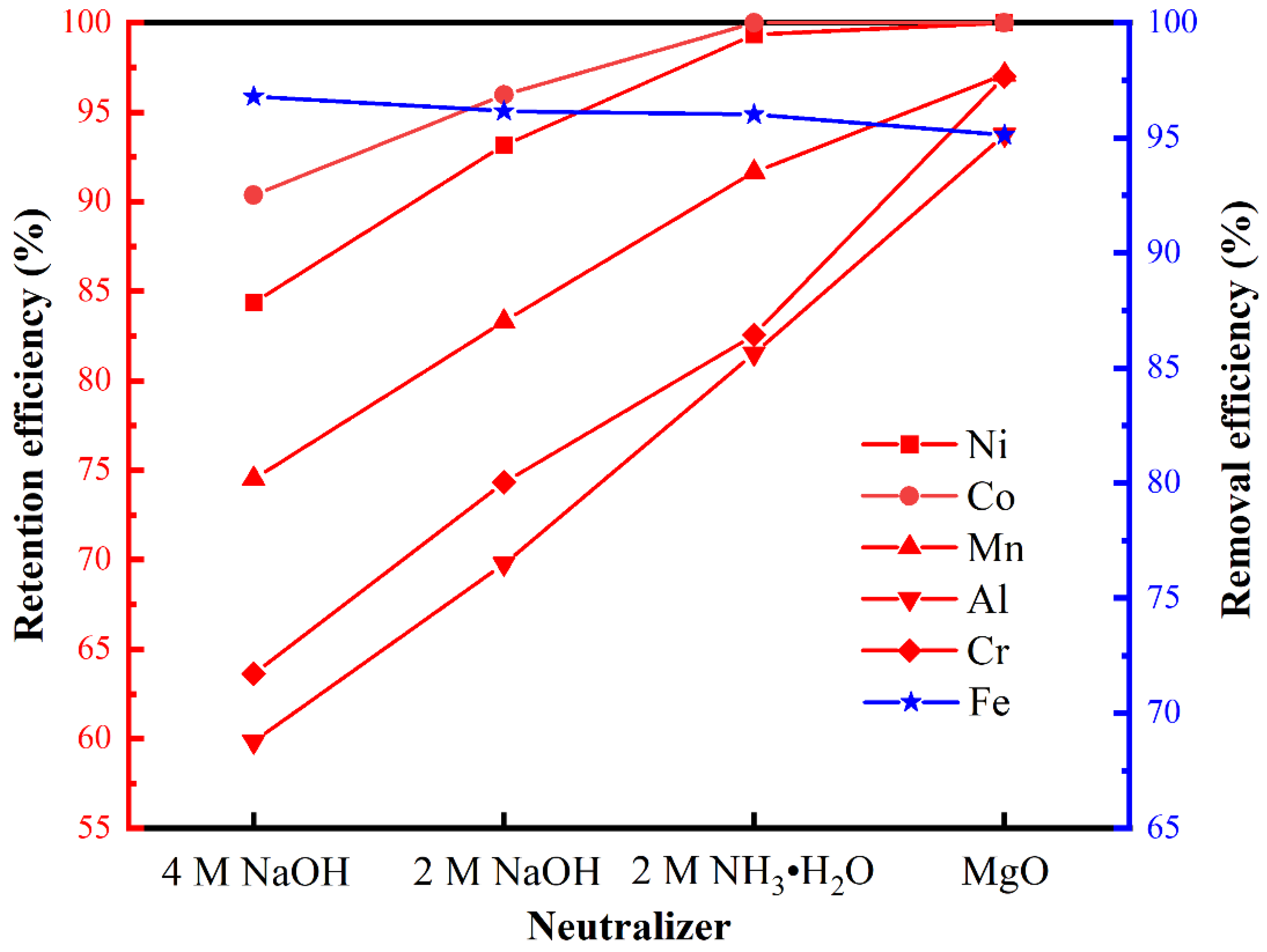
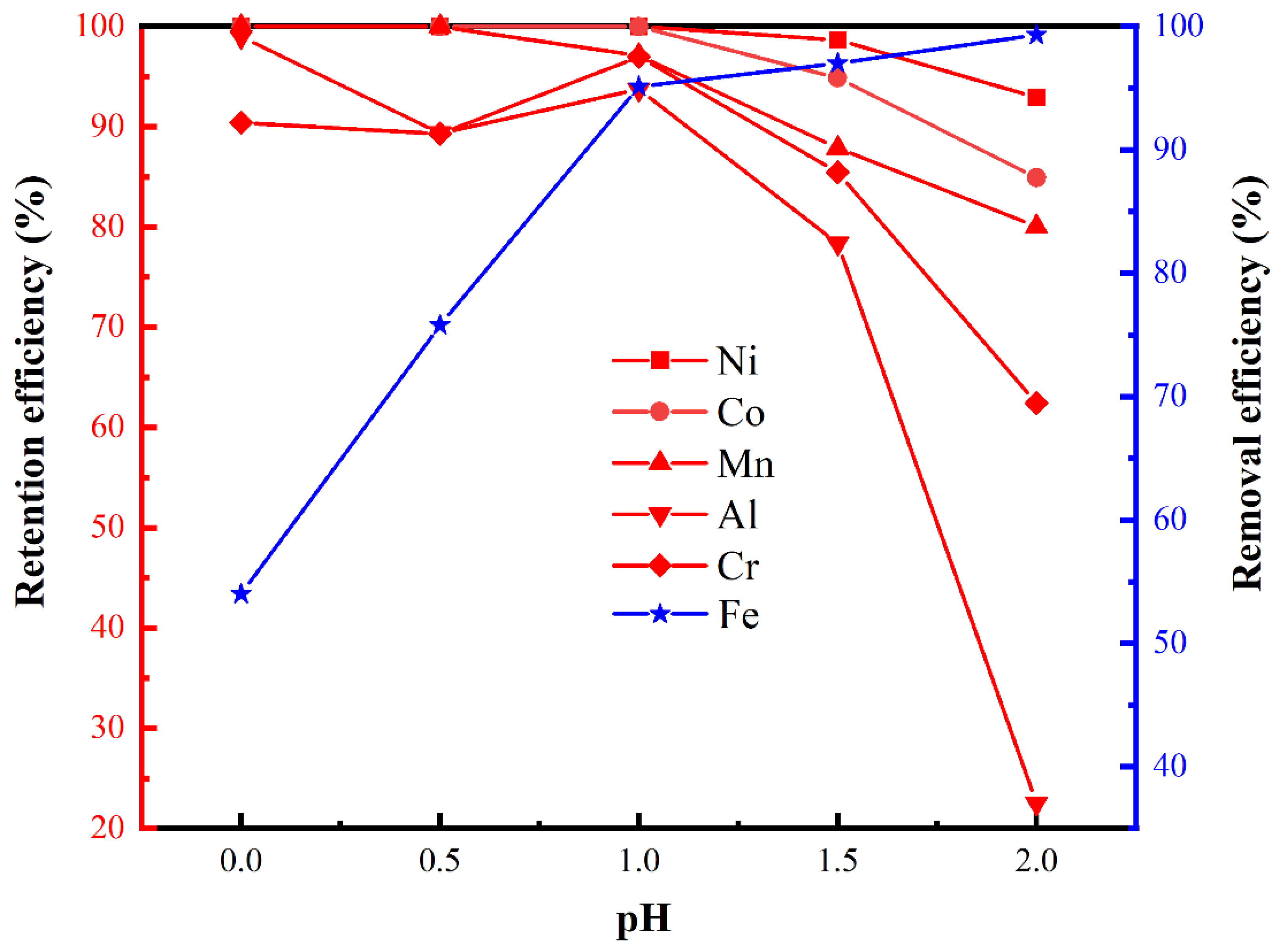
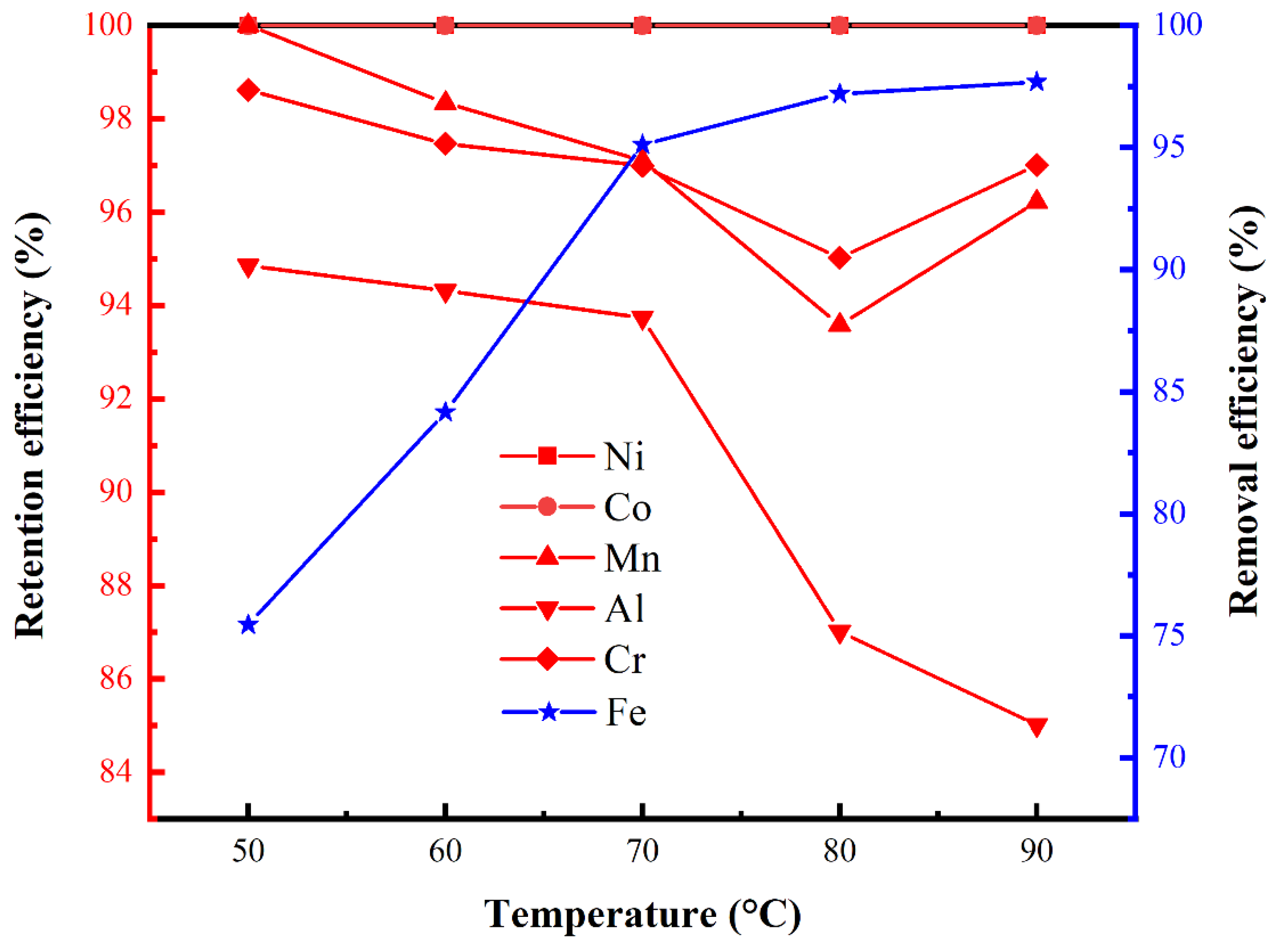
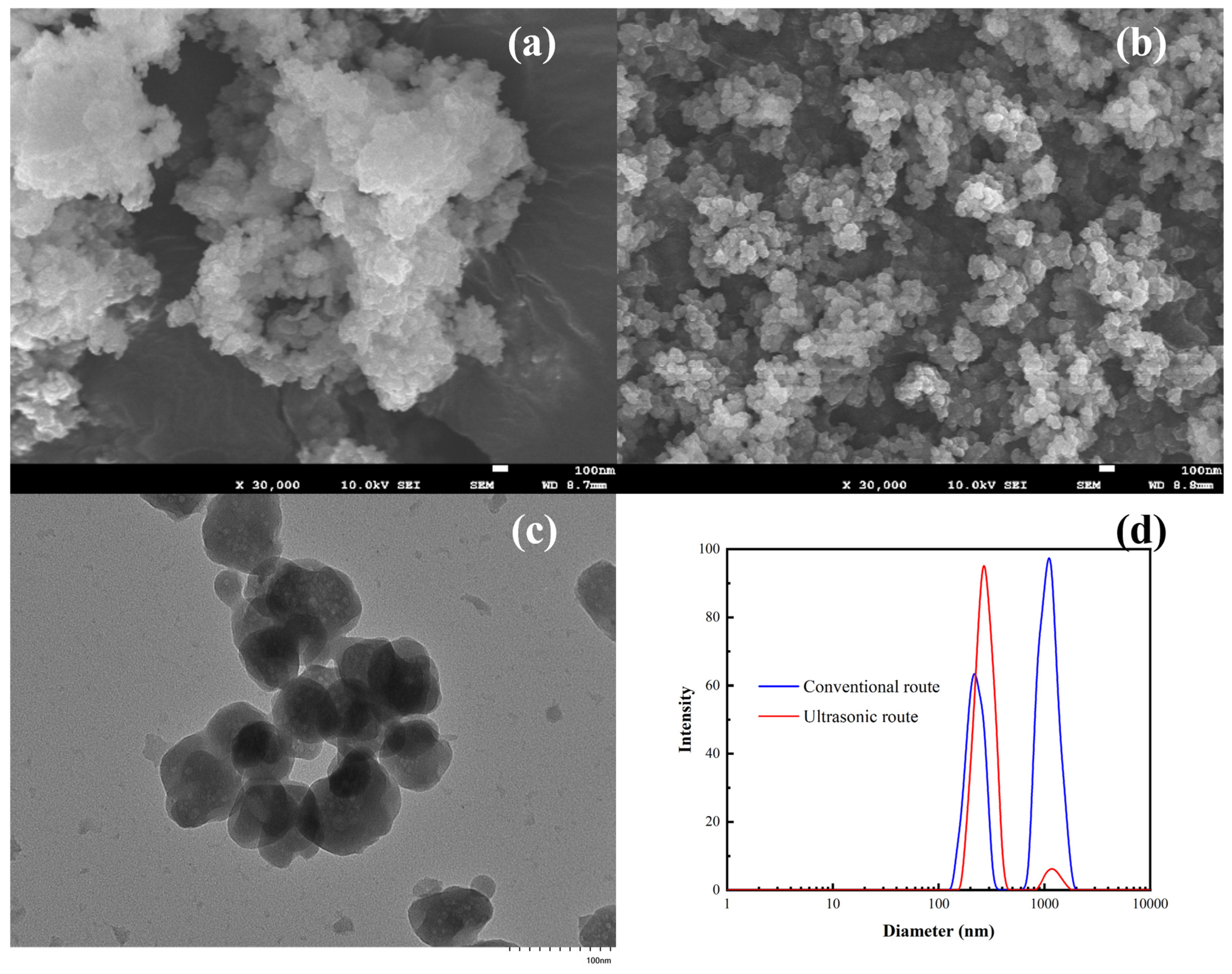
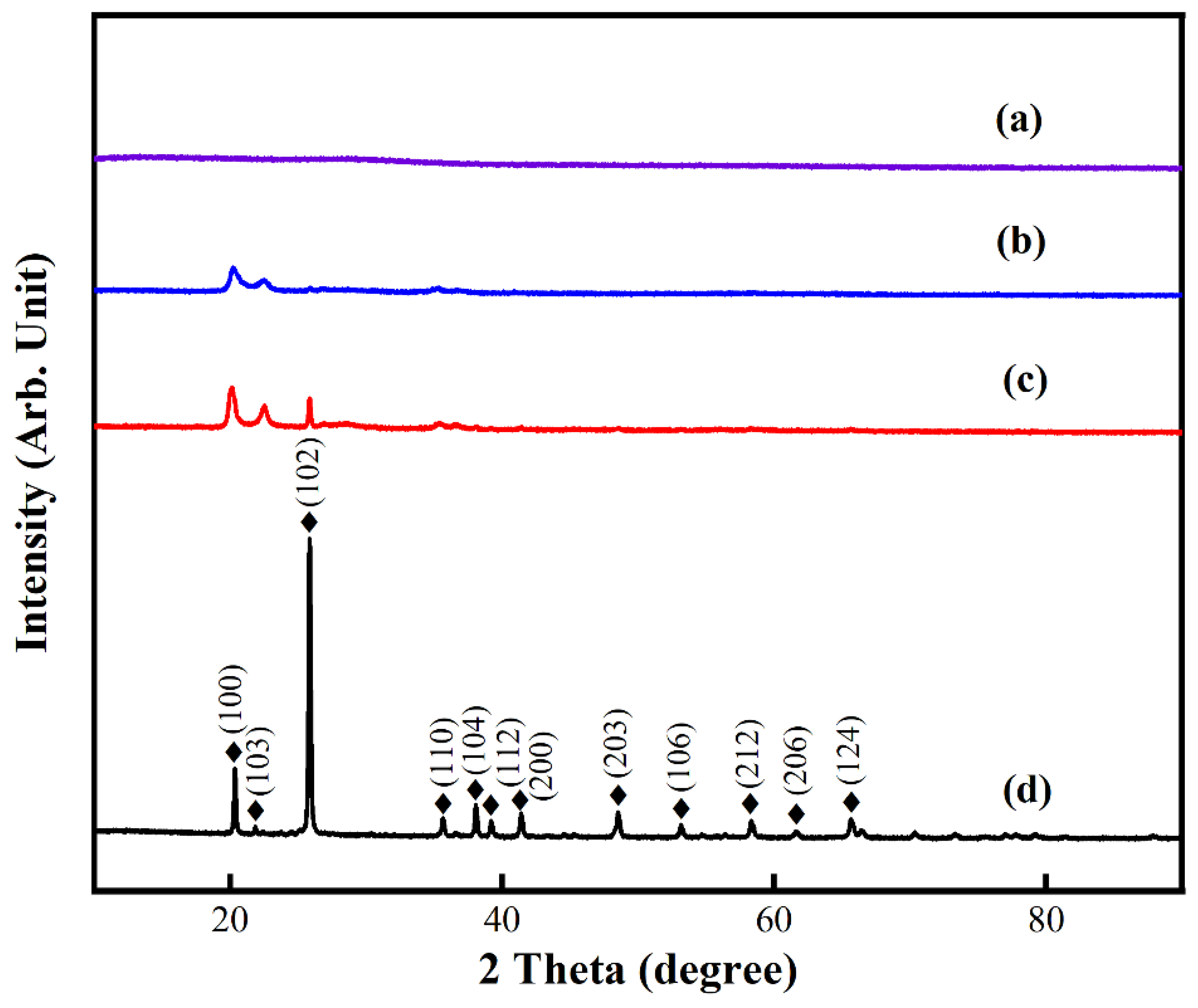
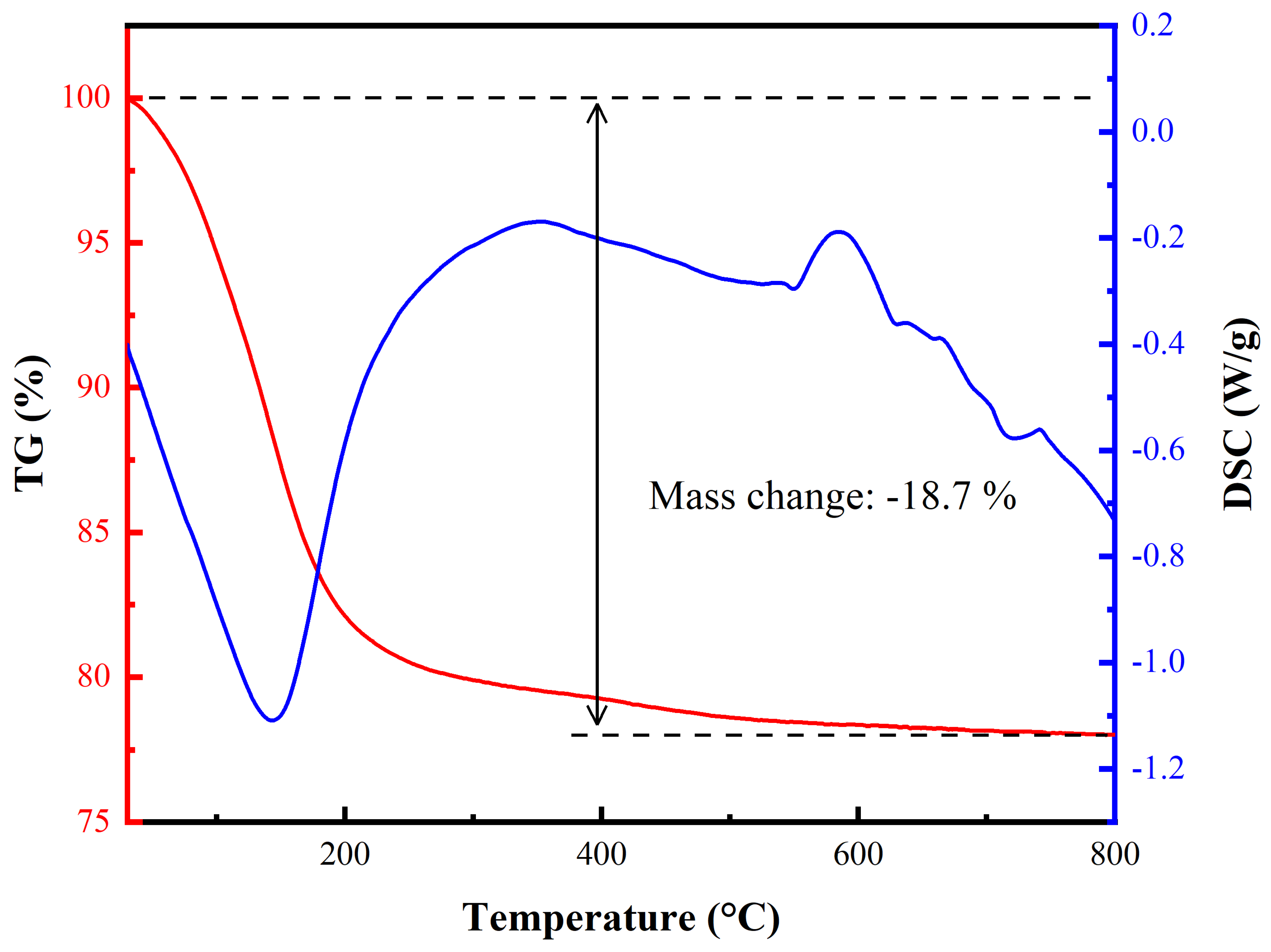

| Ni | Co | Fe | Mn | Mg | Al | Cr | Ca | |
|---|---|---|---|---|---|---|---|---|
| Concentration (g/L) | 0.739 | 0.077 | 34.667 | 0.623 | 0.617 | 1.757 | 0.733 | 0.357 |
| Phosphate pKsp | 31.32 | 34.69 | 21.89 | 31.21 | 23.90 | 18.24 | 21.52 | 28.70 |
| Initial precipitation pH | 2.40 | 2.00 | 0.07 | 2.42 | 3.58 | 1.61 | 0.74 | 2.86 |
| Sample | Fe | P | Ni | Co | Mn | Al | Cr | Fe/P Molar Ratio |
|---|---|---|---|---|---|---|---|---|
| Conventional precipitation | 30.45 | 13.85 | 0 | 0.001 | 0.012 | 0.164 | 0.068 | 1.22 |
| Ultrasonic-assisted precipitation | 28.49 | 13.77 | 0 | 0 | 0.0003 | 0.044 | 0.016 | 1.15 |
Disclaimer/Publisher’s Note: The statements, opinions and data contained in all publications are solely those of the individual author(s) and contributor(s) and not of MDPI and/or the editor(s). MDPI and/or the editor(s) disclaim responsibility for any injury to people or property resulting from any ideas, methods, instructions or products referred to in the content. |
© 2024 by the authors. Licensee MDPI, Basel, Switzerland. This article is an open access article distributed under the terms and conditions of the Creative Commons Attribution (CC BY) license (https://creativecommons.org/licenses/by/4.0/).
Share and Cite
Xu, Z.; Tan, B.; Zhu, B.; Wei, G.; Yu, Z.; Qu, J. Sustainable Utilization of Fe(Ⅲ) Isolated from Laterite Hydrochloric Acid Lixivium via Ultrasonic-Assisted Precipitation to Synthesize LiFePO4/C for Batteries. Materials 2024, 17, 342. https://doi.org/10.3390/ma17020342
Xu Z, Tan B, Zhu B, Wei G, Yu Z, Qu J. Sustainable Utilization of Fe(Ⅲ) Isolated from Laterite Hydrochloric Acid Lixivium via Ultrasonic-Assisted Precipitation to Synthesize LiFePO4/C for Batteries. Materials. 2024; 17(2):342. https://doi.org/10.3390/ma17020342
Chicago/Turabian StyleXu, Ziyang, Boren Tan, Boyuan Zhu, Guangye Wei, Zhihui Yu, and Jingkui Qu. 2024. "Sustainable Utilization of Fe(Ⅲ) Isolated from Laterite Hydrochloric Acid Lixivium via Ultrasonic-Assisted Precipitation to Synthesize LiFePO4/C for Batteries" Materials 17, no. 2: 342. https://doi.org/10.3390/ma17020342
APA StyleXu, Z., Tan, B., Zhu, B., Wei, G., Yu, Z., & Qu, J. (2024). Sustainable Utilization of Fe(Ⅲ) Isolated from Laterite Hydrochloric Acid Lixivium via Ultrasonic-Assisted Precipitation to Synthesize LiFePO4/C for Batteries. Materials, 17(2), 342. https://doi.org/10.3390/ma17020342







